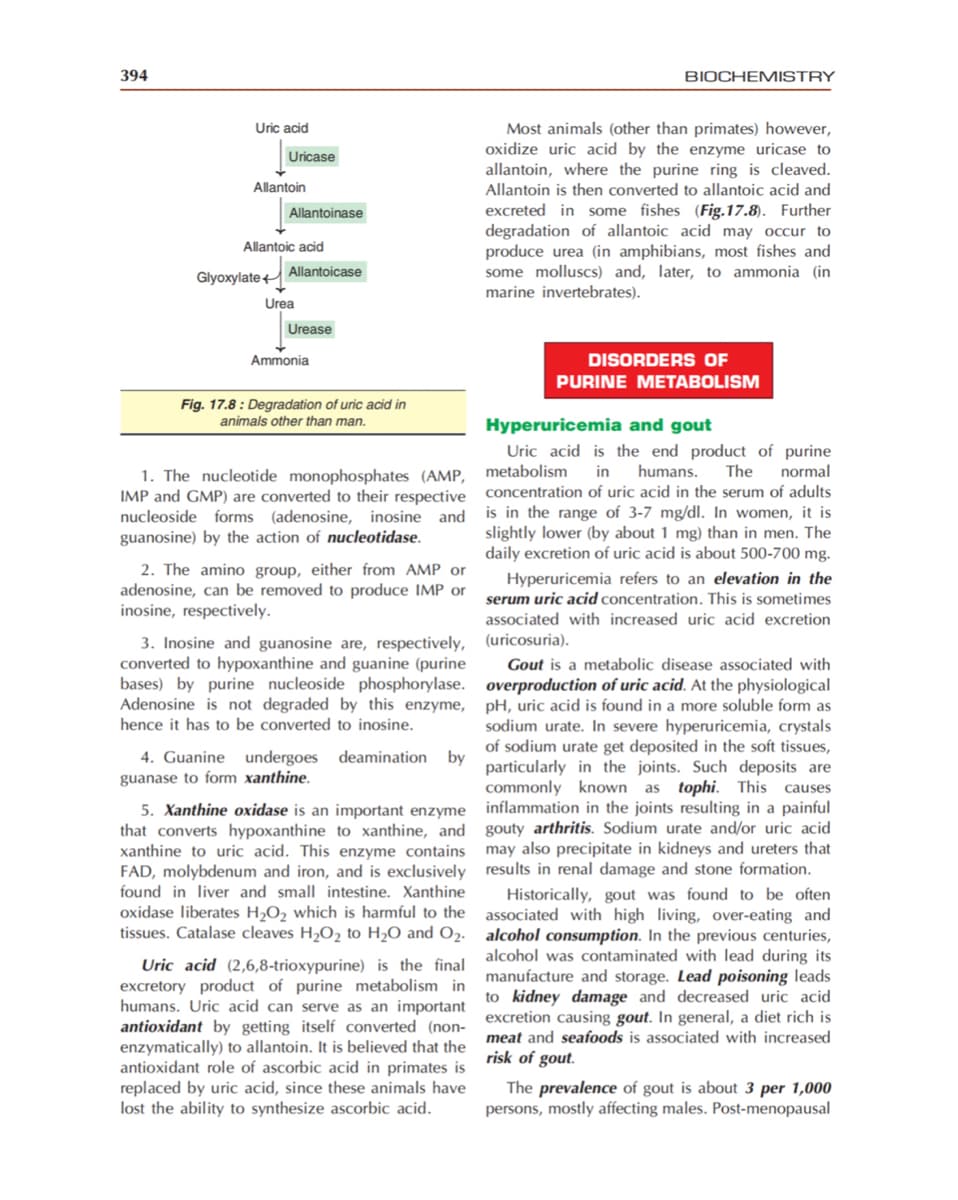Match the metabolic pathway in Figure:17.7 with the reactions listed on 394.
Biochemistry
6th Edition
ISBN:9781305577206
Author:Reginald H. Garrett, Charles M. Grisham
Publisher:Reginald H. Garrett, Charles M. Grisham
Chapter30: Protein Synthesis
Section: Chapter Questions
Problem 21P
Related questions
Question
Match the metabolic pathway in Figure:17.7 with the reactions listed on 394.

Transcribed Image Text:Chapter 17 : METABOLISM OF NUCLEOTIDES
393
AMP deaminase
AMP
IMP
GMP
NH3
H20-
H2O-
Nucleotidase
Nucleotidase
Pit
Nucleotidase
Pit
Pit
NH2
Adenosine
deaminase
HN
HN
H20
NH
N'
H2N
Řibose
Řibose
Ribose
Adenosine
Inosine
Guanosine
PiN Purine nucleoside
Ribose +
phosphorylase
I-phosphate
Pi
Purine
nucleoside
phosphorylase
HN
Ribose
1-phosphate
Нурохanthine
H20 + O2
Xanthine
oxidase
HN
Guanase
HN
NH, HO
H2N°
N.
Guanine
Xanthine
H2O + O2
Хan
oxidase
H2O,
HN
N.
Uric acid
Fig. 17.7 : Degradation of purine nucleotides to uric acid (AMP-Adenosine monophosphate;
IMP-Inosine monophosphate; GMP-Guanosine monophosphate).

Transcribed Image Text:394
BIOCHEMISTRY
Uric acid
Most animals (other than primates) however,
oxidize uric acid by the enzyme uricase to
allantoin, where the purine ring is cleaved.
Allantoin is then converted to allantoic acid and
Uricase
Allantoin
excreted in some fishes (Fig.17.8). Further
degradation of allantoic acid may occur to
produce urea (in amphibians, most fishes and
some molluscs) and, later, to ammonia (in
marine invertebrates).
Allantoinase
Allantoic acid
Glyoxylate
Allantoicase
Urea
Urease
Ammonia
DISORDERS OF
PURINE METABOLISM
Fig. 17.8 : Degradation of uric acid in
animals other than man.
Hyperuricemia and gout
Uric acid is the end product of purine
humans.
1. The nucleotide monophosphates (AMP, metabolism
IMP and GMP) are converted to their respective concentration of uric acid in the serum of adults
nucleoside forms (adenosine, inosine and
guanosine) by the action of nucleotidase.
in
The
normal
is in the range of 3-7 mg/dl. In women, it is
slightly lower (by about 1 mg) than in men. The
daily excretion of uric acid is about 500-700 mg.
2. The amino group, either from AMP or
adenosine, can be removed to produce IMP or
inosine, respectively.
Hyperuricemia refers to an elevation in the
serum uric acid concentration. This is sometimes
associated with increased uric acid excretion
3. Inosine and guanosine are, respectively, (uricosuria).
converted to hypoxanthine and guanine (purine
bases) by purine nucleoside phosphorylase. overproduction of uric acid. At the physiological
Adenosine is not degraded by this enzyme, pH, uric acid is found in a more soluble form as
Gout is a metabolic disease associated with
sodium urate. In severe hyperuricemia, crystals
of sodium urate get deposited in the soft tissues,
hence it has to be converted to inosine.
4. Guanine undergoes deamination by particularly in the joints. Such deposits are
guanase to form xanthine.
commonly known as tophi. This causes
5. Xanthine oxidase is an important enzyme inflammation in the joints resulting in a painful
that converts hypoxanthine to xanthine, and gouty arthritis. Sodium urate and/or uric acid
xanthine to uric acid. This enzyme contains may also precipitate in kidneys and ureters that
FAD, molybdenum and iron, and is exclusively results in renal damage and stone formation.
Historically, gout was found to be often
associated with high living, over-eating and
tissues. Catalase cleaves H2O2 to H2O and O2. alcohol consumption. In the previous centuries,
found in liver and small intestine. Xanthine
oxidase liberates H,O2 which is harmful to the
Uric acid (2,6,8-trioxypurine) is the final alcohol was contaminated with lead during its
excretory product of purine metabolism in
humans. Uric acid can serve as an important
antioxidant by getting itself converted (non- excretion causing gout. In general, a diet rich is
enzymatically) to allantoin. It is believed that the
antioxidant role of ascorbic acid in primates is
replaced by uric acid, since these animals have
lost the ability to synthesize ascorbic acid.
manufacture and storage. Lead poisoning leads
to kidney damage and decreased uric acid
meat and seafoods is associated with increased
risk of gout.
The prevalence of gout is about 3 per 1,000
persons, mostly affecting males. Post-menopausal
Expert Solution
This question has been solved!
Explore an expertly crafted, step-by-step solution for a thorough understanding of key concepts.
Step by step
Solved in 7 steps with 5 images

Recommended textbooks for you

Biochemistry
Biochemistry
ISBN:
9781305577206
Author:
Reginald H. Garrett, Charles M. Grisham
Publisher:
Cengage Learning

Biology: The Unity and Diversity of Life (MindTap…
Biology
ISBN:
9781305073951
Author:
Cecie Starr, Ralph Taggart, Christine Evers, Lisa Starr
Publisher:
Cengage Learning

Anatomy & Physiology
Biology
ISBN:
9781938168130
Author:
Kelly A. Young, James A. Wise, Peter DeSaix, Dean H. Kruse, Brandon Poe, Eddie Johnson, Jody E. Johnson, Oksana Korol, J. Gordon Betts, Mark Womble
Publisher:
OpenStax College

Biochemistry
Biochemistry
ISBN:
9781305577206
Author:
Reginald H. Garrett, Charles M. Grisham
Publisher:
Cengage Learning

Biology: The Unity and Diversity of Life (MindTap…
Biology
ISBN:
9781305073951
Author:
Cecie Starr, Ralph Taggart, Christine Evers, Lisa Starr
Publisher:
Cengage Learning

Anatomy & Physiology
Biology
ISBN:
9781938168130
Author:
Kelly A. Young, James A. Wise, Peter DeSaix, Dean H. Kruse, Brandon Poe, Eddie Johnson, Jody E. Johnson, Oksana Korol, J. Gordon Betts, Mark Womble
Publisher:
OpenStax College

Biology: The Unity and Diversity of Life (MindTap…
Biology
ISBN:
9781337408332
Author:
Cecie Starr, Ralph Taggart, Christine Evers, Lisa Starr
Publisher:
Cengage Learning